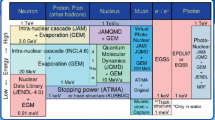Abstract
In the physical processes of proton interaction in bio-materials, most of the proton energy is transferred to electrons. Ionization and excitation occur most frequently around the Bragg peak region, where nuclear reactions also exist. In this study, we investigated the processes of energy deposition by considering interactions including the nuclear reactions between protons and water molecules by a Monte Carlo simulation for proton therapy. We estimated the number of particles produced by a variety of nuclear reactions, and we focused on the interaction in the low-energy region (below 1 MeV). Furthermore, we considered the charge-changing processes in the low-energy region (less than a few hundred keV). Finally, we evaluated the total dose and the contribution of primary protons and secondary particles through nuclear reactions to the absorbed dose. The results showed that the protons generate numerous neutrons via nuclear reactions. Particularly, neutrons with relatively low energies produce recoil protons by elastic collisions with the hydrogen atoms. Around the Bragg peak, low-energy primary protons (slowed-down protons) are prevalent, whereas recoil (secondary) protons gradually become dominant behind the distal falloff region of the Bragg peak. Therefore, around the Bragg peak, the main contribution to the absorbed dose is that of the primary protons (from 80 to 90%), whereas secondary protons created by primary proton-induced reactions contribute to the dose from 20 to 5%. Behind the distal endpoint of the Bragg peak, the absorbed dose is mainly due to the protons produced by 1H(n, p), and the contribution of these is about 70%.





Similar content being viewed by others
References
Nikjoo H, Uehara S, Emfietzoglou D, Cucinotta FA. Track-structure codes in radiation research. Radiat Meas. 2006;41:1052–74.
Date H, Sutherland KL, Hayashi T, Matsuzaki Y, Kiyanagi Y. Inelastic collision processes of low-energy protons in liquid water. Radiat Phys chem. 2006;75:179–87.
Nishio T, Sato T, Kitamura H, Murakami K, Ogino T. Distributions of β+ decayed nuclei generated in the CH2 and H2O targets by the target nuclear fragment reaction using therapeutic MONO and SOBP proton beam. Med Phys. 2005;32:1070–82.
Oelfke U, Lam GKY, Atkins MS. Proton dose monitoring with PET: quantitative studies in Lucite. Phys Med Biol. 1996;41:177–96.
Iwase H, Niita K, Nakamura T. Development of general-purpose particle and heavy ion transport Monte Carlo code. J Nucl Sci Technol. 2002;39:1142–51.
Fippel M, Soukup M. A Monte Carlo dose calculation algorithm for proton therapy. Med Phys. 2004;31:2263–73.
Paganetti H. Nuclear interactions in proton therapy: dose and relative biological effect distributions originating from primary and secondary particles. Phys Med Biol. 2002;47:747–64.
Schneider U, Agosteo S, Pedroni E, Besserer J. Secondary neutron dose during proton therapy using spot scanning. Int J Radiat Oncol Biol Phys. 2002;53:244–51.
Dingfelder M, Inokuti M, Paretzke HG. Inelastic-collision cross sections of liquid water for interactions of energetic protons. Radiat Phys chem. 2000;59:255–75.
Uehara S, Toburen LH, Wilson WE, Goodhead DT, Nikjoo H. Calculations of electronic stopping cross sections for low-energy protons in water. Radiat Phys chem. 2000;59:1–11.
International Commission on Radiation Units and Measurements, Bethesda, Maryland. Stopping powers and ranges for protons and alpha particles. ICRU Report 49; 1993.
Niita K, Takada H, Meigo S, Ikeda Y. High-energy particle transport code NMTC/JAM. Nucl Instr Method Phys Res B. 2001;184:406–20.
X-5 Monte Carlo Team of Diagnostics Applications Group (Los Alamos National Laboratory). MCNP-A general Monte Carlo N-particle transport code, Version 5. LA-UR-03-1987; 2003.
Armstrong TW, Chandler KC. SPAR, a Fortran program for computing stopping powers and ranges for muons, charged pions, protons, and heavy ions. ORNL-4869; 1973.
Pelowitz DB, editor. MCNPX user’s manual, Version 2.5.0. LA-CP-05-0369; 2005.
Niita K, Sato T, Iwase H, Nose H, Nakashima H, Sihver L. PHITS—a particle and heavy ion transport code system. Radiat. Meas. 2006;41:1080–90.
Chu WT, Ludewigt BA, Renner TR. Instrumentation for treatment of cancer using proton and light-ion beams. Rev Sci Instrum. 1993;64:2055–121.
Niita K, Meigo S, Takada H, Ikeda Y. High energy particle transport code NMTC/JAM. Jaeri-Data/Code 2001-007; 2001.
Iwase H, Niita K. PHITS Ver.2.08 user’s manual. Research Organization for Information Section and Technology (RIST); 2006.
Chadwick MB, Young PG, MacFarlane RE, Moller P, Hale GM, Little RC, et al. LA150 documentation of cross sections, heating, and damage: Part A (Incident Neutrons) and Part B (Incident Protons). LA-UR-99-1222; 1999.
Annals of the ICRP Publication 103. The 2007 recommendations of the International Commission on Radiological Protection; 2008.
Acknowledgments
The authors are most grateful to the editor and the referees for encouraging us and giving us the opportunity to revise the manuscript. This work was supported in part by a Grant-in-Aid for Scientific Research from the Ministry of Education, Culture, Sports, Science and Technology, Japan.
Author information
Authors and Affiliations
Corresponding author
About this article
Cite this article
Matsuzaki, Y., Date, H., Sutherland, K.L. et al. Nuclear collision processes around the Bragg peak in proton therapy. Radiol Phys Technol 3, 84–92 (2010). https://doi.org/10.1007/s12194-009-0081-2
Received:
Revised:
Accepted:
Published:
Issue Date:
DOI: https://doi.org/10.1007/s12194-009-0081-2




